#diebold lauber
Text

judith slaying holofernes
illustration from a "historienbibel", illuminated by the workshop of diebold lauber, hagenau (alsace), c. 1447-55
source: St. Gallen, Kantonsbibl., VadSlg Ms. 343C, fol. 261v
824 notes
·
View notes
Photo
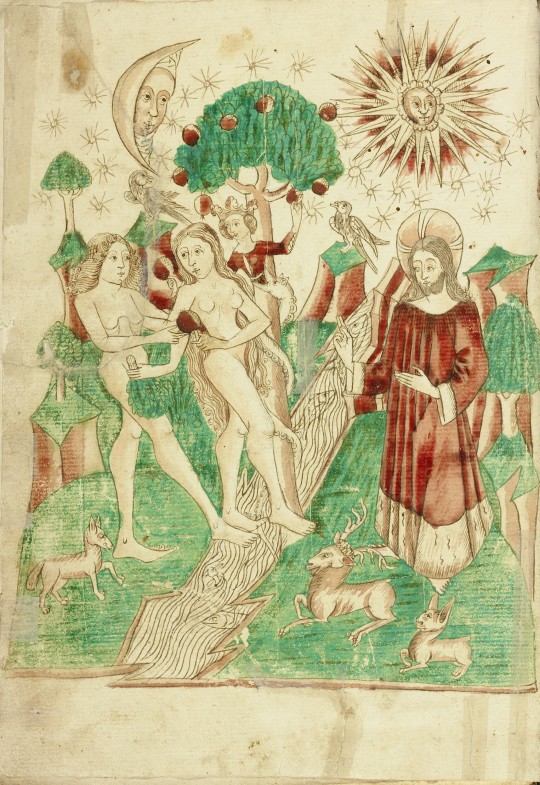
The Garden of Eden and Adam and Eve Eating the Forbidden Fruit (1469) Follower of Hans Schilling (German, active 1459 - 1467), from the Workshop of Diebold Lauber (German, active 1427 - 1467)
248 notes
·
View notes
Text

Theodas with the Book of Magic and the Devil, from Barlaam and Josaphat, 1469, Workshop of Diebold Lauber. The J. Paul Getty Museum
1 note
·
View note
Photo
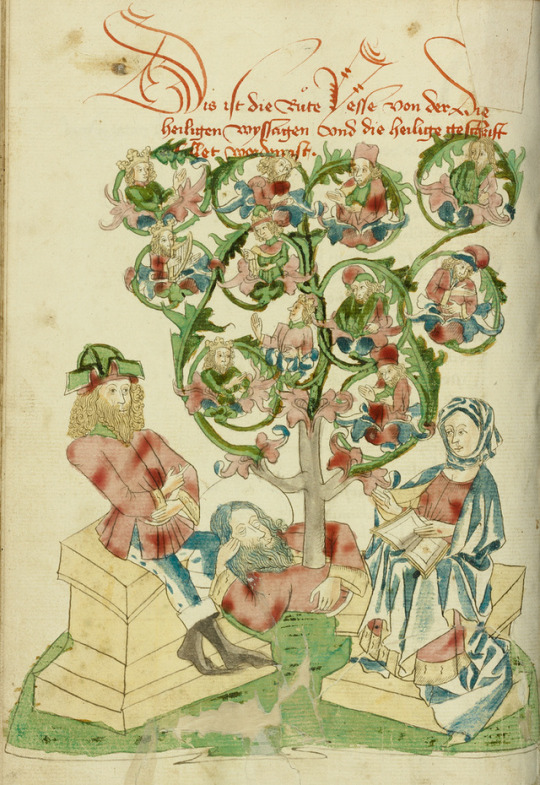
‘The Tree of Jesse’ (1469) from the Workshop of Diebold Lauber (German, active 1427 - 1467) .
Ink, coloured washes and tempera.
Image and text courtesy The Getty.
This image is available for download, without charge, under the Getty's Open Content Program.
23 notes
·
View notes
Photo
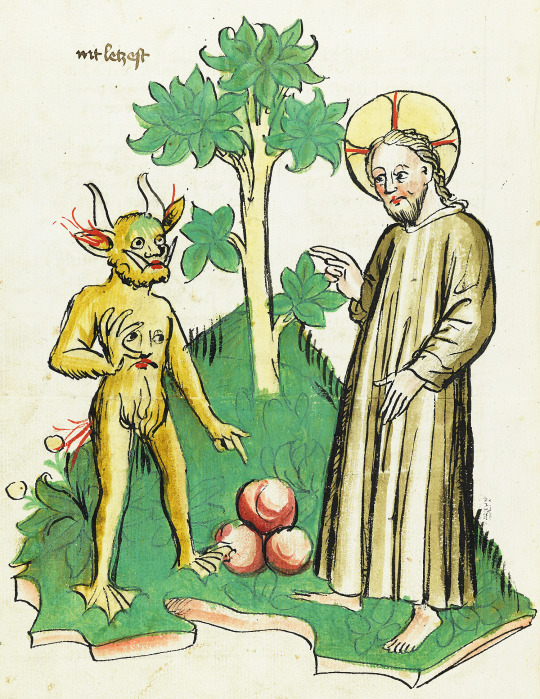
Temptation of Christ by the devil. Historienbibel from the workshop of Diebold Lauber ~ ca.1460 Zentralbibliothek • via Bibliothèque Infernale on FB
284 notes
·
View notes
Photo

The Lady with the unicorn. Diebold Lauber Das Buch der Natur. Heidelberg UB. Cod. Pal. germ. 300, fol. 115v. about 1442 to 1448.
46 notes
·
View notes
Photo
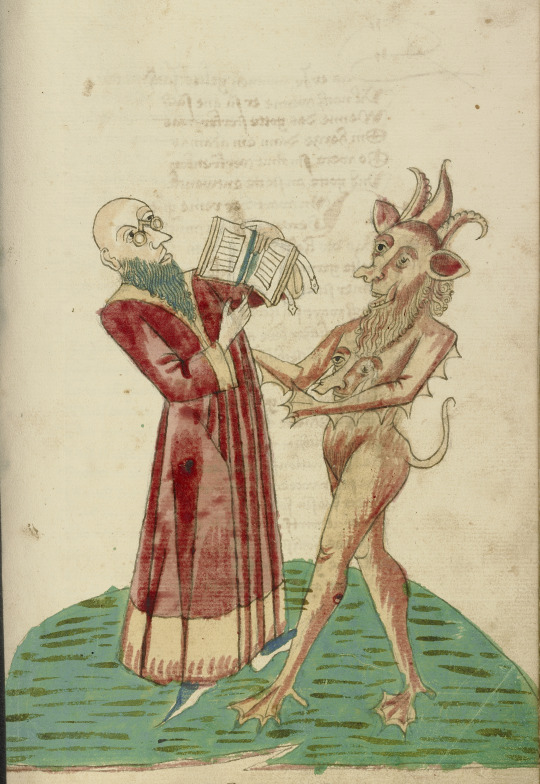
Theodas with the Book of Magic and the Devil, Follower of Hans Schilling from the Workshop of Diebold Lauber, Hagenau, Alsace, 1469, Ms. Ludwig XV 9 (83.MR.179), fol. 280, The J. Paul Getty Museum, Los Angeles.
82 notes
·
View notes
Photo
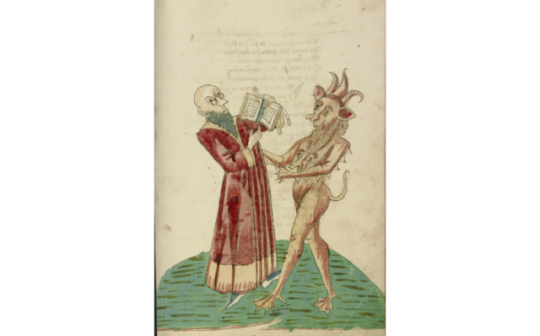
Theodas with the Book of Magic and the Devil Artists/Makers: Follower of Hans Schilling (German, active 1459 - 1467) from the Workshop of Diebold Lauber (German, active 1427 - 1467) Date: 1469 Medium: Ink, colored washes, and tempera colors on paper
The Getty
22 notes
·
View notes
Photo

Multi-directional tiddies. Useful for finding your way if you’re lost in the woods.
Josaphat Enthroned Tempted by a Naked Woman by a Follower of Hans Schilling from the Workshop of Diebold Lauber
0 notes
Photo

A Landscape with Trees, Thorn Bushes, and a Dove. Follower of Hans Schilling, from the workshop of Diebold Lauber, 1469. Ink, coloured washes, and tempera colours on paper.
4 notes
·
View notes
Text

alexander the great in the bathysphere
illustration from a "historienbibel", created and illuminated by the workshop of diebold lauber, hagenau (alsace), c. 1460
source: Solothurn, Zentralbibliothek, Cod. S II 43, fol. 289r
#15th century#historienbibel#diebold lauber#alexander#alexander the great#underwater diving#bathysphere#kings#queens#illuminated manuscript
225 notes
·
View notes
Photo

Theodas with the Book of Magic and the Devil, from Barlaam and Josaphat, 1469, Workshop of Diebold Lauber.
92 notes
·
View notes
Photo

Illuminated page (1442–1451) by Konrad von Megenberg from ‘Das Buch der Natur.’
Werkstatt Diebold Lauber, Hagenau.
This file is made available under the Creative Commons CC0 1.0 Universal Public Domain Dedication
Wikimedia.
260 notes
·
View notes
Photo

Between us and you a great chasm is established
The scene is the start of one of the most iconic stories of the New Testament. Lazarus, covered with sores and licked by dogs, will find his reward in heaven. The rich man who denied Lazarus even the crumbs from his table will burn in Hell:
“…and from the netherworld, where he was in torment, he raised his eyes and saw Abraham far off and Lazarus at his side. And he cried out, ‘Father Abraham, have pity on me. Send Lazarus to dip the tip of his finger in water and cool my tongue, for I am suffering torment in these flames.’ Abraham replied, ‘My child, remember that you received what was good during your lifetime while Lazarus likewise received what was bad; but now he is comforted here, whereas you are tormented. Moreover, between us and you a great chasm is established to prevent anyone from crossing who might wish to go from our side to yours or from your side to ours.’”
This drawing (ink, colored washes, and tempera colors on paper) from the Getty Museum was made around 1470 in the workshop of Diebold Lauber in Hagenau, Alsace, France.
0 notes
Text
Hyperallergic: Tracing the Lives of Women in Medieval Manuscript Illustrations
Master of the Chronique scandaleuse, “Denise Poncher before a Vision of Death” (Paris, France, about 1500), tempera colors, ink and gold on parchment; Leaf: (5 1/4 × 3 7/16 inches) (courtesy the J. Paul Getty Museum, Los Angeles, Ms. 109, fol. 156)
“We don’t have a lot of records of women’s voices in the Middle Ages,” Christine Sciacca, former assistant curator of manuscripts at the J. Paul Getty Museum and now associate curator of European art at the Walters Art Museum, told Hyperallergic. “A lot of the records that come down to us were written by men and they’re about men’s deeds.”
Sciacca is the curator of Illuminating Women in the Medieval World, now at the J. Paul Getty Museum’s Getty Center in Los Angeles, where she delved into its collection of illuminated manuscripts to find these lost voices of medieval women. She also authored an accompanying publication that includes manuscripts beyond the around 23 selected objects from the Getty, such as those by late medieval author Christine de Pizan. In images of saints, queens, the Virgin Mary, female martyrs, and aristocratic women who commissioned manuscripts, are traces of their overlooked lives. A portrait of Saint Anne teaching the Virgin Mary to read — a scene which likely never happened — may have reflected a mother’s interest in literacy for her daughters, while images of peasant women spinning wool offers visual insight into their work in the textile industry.
Master of Sir John Fastolf, “Saint Anne Teaching the Virgin to Read” (France, about 1430 – 1440), tempera colors, gold leaf, and ink on parchment; Leaf: 4 3/4 × 3 5/8 inches (courtesy the J. Paul Getty Museum, Los Angeles, Ms. 5, fol. 45v)
“At the same time, we learn a lot about the perceptions of medieval women by medieval society,” Sciacca said. Obedience and motherhood are repeating themes, which were reinforced in the pocket-sized books of hours used by medieval women for religious contemplation. Yet the saints and biblical figures on their pages weren’t represented in their ancient eras; instead, they were illustrated in medieval settings, dressed like their intended readers.
“These things made it much more appealing and understandable to a reader at that time, who could picture themselves in the role of Mary,” Sciacca explained. And sometimes, an image of the reader would be illustrated right in the book. One 16th-century example in Illuminating Women shows Denise Poncher being approached by a skeleton, three corpses in its wake. “She’s kneeling there, in a beautiful gown that gives you a sense of her wealth, her prayer book open, and she’s being loomed over by this horrible specter of death, a skeleton whose flesh is rotten,” Sciacca said. “It’s a reminder that even though you’re young and beautiful now, you, too, will die. This book fits in the palm of your hand, it’s quite small, and this was her personal prayer book. When she’s praying with this book, she can really meditate on this image of death.”
Other artwork in Poncher’s book further pointed her to the path expected of a medieval woman, including childbearing through images of Mary — guidance that was, of course, being conveyed by men. Depictions of Eve and Bathsheba as temptresses similarly warned women on “bad” behavior. There were women artists and patrons who influenced the subjects, a few of whom are named in Illuminating Women. Margaret of York commissioned eight books, one of which is at the Getty and follows a knight who passes out at a dinner party and takes a dream journey through heaven, hell, and purgatory. Jeanne de Montbaston was an illuminator who ran a Paris bookshop with her husband, creating manuscripts in a collaborative process, and got official permission to continue independently after his death.
Sciacca pointed out that, while women have much greater independence now, many of these expectations of piousness and gender roles remain. “We tend to think in the past they were really misogynistic, but some of these things are still very true today,” she said. And although the perspectives of women rarely made it into the texts of the Middle Ages, “there are their aspirations and desires that you find in the manuscripts if you pay attention to them.”
Workshop of Master of the First Prayer Book of Maximilian, “Mary Magdalene with a Book and an Ointment Jar” (Bruges, Belgium, about 1510-20), tempera colors, gold, and ink on parchment; Leaf: 9 1/8 x 6 9/16 inches (courtesy the J. Paul Getty Museum, Los Angeles, Ms. Ludwig IX 18, fol. 264v)
Spitz Master, “Saint Catherine Tended by the Angels and Visited by the Queen” (Paris, France, about 1420), tempera colors, gold, and ink on parchment; Leaf: 7 15/16 x 5 7/8 inches (courtesy the J. Paul Getty Museum, Los Angeles, Ms. 57, fol. 45v)
Follower of Hans Schilling, from the Workshop of Diebold Lauber, “Judith Slaying Holofernes (Jael Slaying Sisera)” (Haguenau, Alsace, 1469), ink, colored washes, and tempera colors on paper; Leaf: 11 1/4 × 8 inches (courtesy the J. Paul Getty Museum, Los Angeles, Ms. Ludwig XV 9, fol. 61v)
Simon Bening, “The Annunciation” (Bruges, Belgium, about 1525-30), tempera colors, gold paint, and gold leaf on parchment; Leaf: 6 5/8 × 4 1/2 inches (courtesy the J. Paul Getty Museum, Los Angeles, Ms. Ludwig IX 19, fol. 13v)
Follower of the Egerton Master, “The Virgin and Child and a Woman in Prayer” (Paris, France, about 1410), tempera colors, gold leaf, gold paint, and ink on parchment; Leaf: 7 1/2 × 5 1/2 inches (courtesy the J. Paul Getty Museum, Los Angeles, Ms. Ludwig IX 5, fol. 23)
Unknown artist, “The Drunken Harlot” (Probably London, about 1255-60), tempera colors, gold leaf, colored washes, pen and ink on parchment; Leaf: 12 9/16 x 8 7/8 inches (courtesy the J. Paul Getty Museum, Los Angeles, Ms. Ludwig III 1, fol. 36v)
Illuminating Women in the Medieval World continues at the Getty Center (1200 Getty Center Drive, Los Angeles) through September 17.
The post Tracing the Lives of Women in Medieval Manuscript Illustrations appeared first on Hyperallergic.
from Hyperallergic http://ift.tt/2vDR0Vc
via IFTTT
0 notes
Photo

Josaphat in Prayer is Tempted by the Devil But Protected by an Angel
Artists/Makers: Follower of Hans Schilling (German, active 1459 - 1467) from the Workshop of Diebold Lauber (German, active 1427 - 1467) Date: 1469 Medium: Ink, colored washes, and tempera colors on paper
The Getty
9 notes
·
View notes